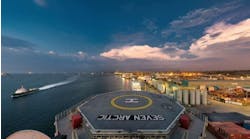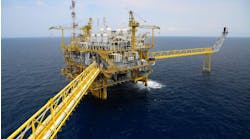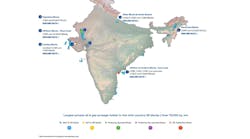Hugin-1 on its containerized launch/recovery sledge.A new type of untethered underwater vehicle (UUV) - Hugin - promises to bring much greater precision to such tasks as seabed mapping and inspection in deep waters than conventional technology can provide.
Having been successfully put through its paces in sea trials last year, the first version will be ready for commercial operations in the late autumn. It is the product of the Hugin development group, which comprises Statoil, the Norwegian Defence Research Institute (FFI), Kongsberg Simrad and the Norwegian Underwater Technology Centre (Nutec).
For the offshore sector, Hugin offers a cost-effective solution for activities such as detailed surveying of pipeline routes and sites for subsea production facilities, and monitoring such facilities when in place.
The development was prompted by the limitations on the ROV and towed fish systems used in shallower waters, according to Martin Sigmundstad, Statoil's vice president, Offtech Industrial Development. As water depths increase, the ROV requires an increasing proportion of its power to pull the umbilical; the consequent slowing in speed considerably lengthens the time, and cost, of the survey. For towed fish, the positioning and operating speed deteriorates as water depth increases.
Hugin has so far been developed to operate in depths down to 600 meters. The project is due to start a second stage in the autumn with the development of a unit designed to operate in depths down to 2,000 meters, Sigmundstad says.
The torpedo-shaped vehicle is 4.8 metres long and has a total volume of 1.2 cu meters. The hull, which is shaped to minimize hydrodynamic drag, is made of glass- and carbon-fiber reinforced plastic.
The total power requirement to achieve a constant velocity of four knots is 300 W. Another 300 W is used for data collection and communications. Power is provided by a battery system integrating a seawater battery and fuel cell technology which gives it 36 hours' continuous operation, equivalent to a range of 144 nautical miles.
The unit, which is controlled acoustically from the mother ship, can be given commands in real time and also pre-programmed with course and work tasks. Positioning accuracy, both in relation to the seabed survey area and the mother vessel, is provided by a Doppler velocity log, a motion reference unit, and the new HiPAP acoustic positioning system developed by Kongsberg Simrad.
A multibeam echo-sounder, also developed by Kongsberg Simrad, provides high resolution mapping. The system has been optimized for measuring within an angular sector of 120 degrees, giving a maximum swath width of almost 200 meters at 60 meters altitude. Data is mostly stored on board, though a part is transmitted acoustically to the surface in near real time for quality assurance purposes as the operation proceeds.
The vehicle comes in a container together with all supporting equipment, including a sea-state tolerant launch and recovery system, and is intended for deployment from the type of vessel normally used for survey operations.
Two Hugin units have been built, one which Nutec will offer for the use of offshore survey companies and another for the defense partner. The development is so far within the original budget of NKr 35 million.
In addition to seabed mapping, there are many other deep-water tasks Hugin can be equipped to undertake, Sigmundstad says, such as geophysical mapping, sniffing for hydrocarbons on the seabed, and environmental and fish stock monitoring.
Copyright 1997 Oil & Gas Journal. All Rights Reserved.


